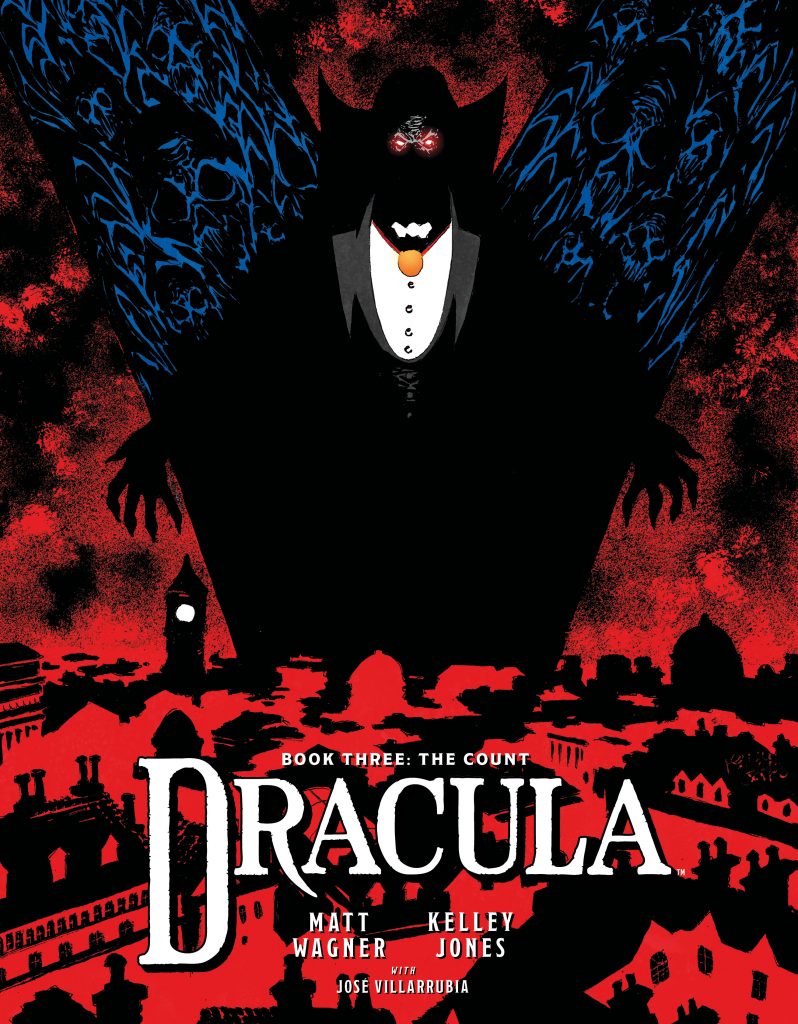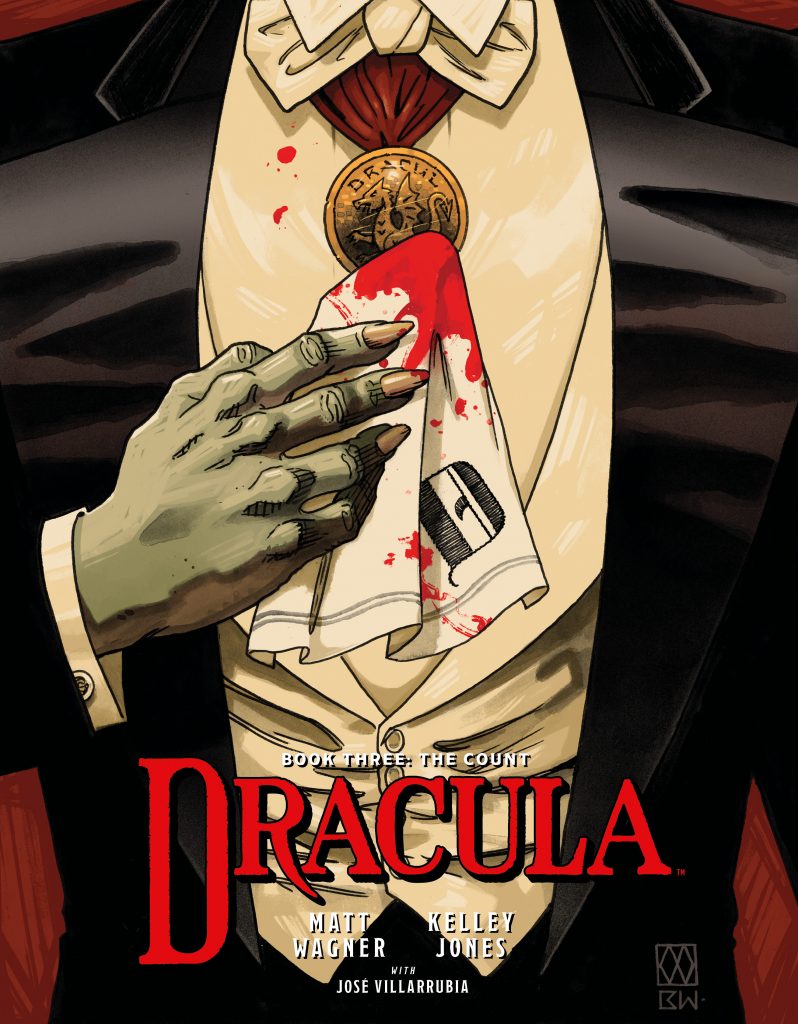For the past two Octobers, horror in comics has been dominated by two legendary comic creators at the top of their game.
Matt Wagner (creator of Grendel) and Kelley Jones (Sandman: Season of Mists; Batman & Dracula: Red Rain) tackled the crevices of the world’s most famous vampire’s history in their comics Dracula: Book I – The Impaler and Dracula: Book II – The Brides, which each had overwhelming success crowdfunding on Kickstarters through Orlok Press. Impaler examines the Count’s time under Satan’s thumb and rise to his status of the dark lord, while The Brides examined the connection between Dracula and his titular trio.
And just two days ago on October 1, just in time for spooky season, Jones and Wagner launched a new Kickstarter through Orlok Press to continue the story of the scourge of the night in Dracula: Book III – The Count. In The Count, the duo will shine a light on Dracula’s inner world—what he thinks of himself, what drives him, and the self-awareness he has about his actions. They also delve deep into how he navigates his world and how he interacts with the people in it.
I recently spoke with Kelley Jones and Matt Wagner about the conceit of Dracula: Book III – The Count, how their focus on Dracula himself guided this volume, the continuing staying power and interest in the Count and his world, and what the duo have planned next for the vampire.
The first two volumes of Wagner and Jones’ Dracula books are dizzying and takes the Count and the readers places that have never felt so new. They are titans who have conquered horror in comics and have no signal of slowing down.

FreakSugar: Thank you both for speaking with us again! We really appreciate it and digging into Dracula lore with you.
You mention in the press release that in the original novel from Bram Stoker that we only see Dracula from the point of view of others. With The Count giving us a window into inner world, what does Dracula think of himself? How does he see himself in a way others might not?
Matt Wagner: It’s an old storytelling adage that no one actually thinks of themselves as a villain…but that’s not true in Dracula’s case. He’s fully aware that he was personally chosen and anointed with vampirism by Satan himself. It just so happens that his role as the Devil’s emissary also meshes seamlessly with his undying lust for power and his willingness to wreak carnage in order to achieve it. He is still prey to a variety of human emotions and we do see a few instances where he experiences loss and regret but at heart he’s still a merciless bastard.
There’s a latent cruelty to Dracula that he definitely finds enjoyable and that was true when he was still alive as well. The reports of Vlad Tepeś, the real-life inspiration for the character of Dracula, of his brutality and his apparent glee at seeing people killed and tortured is both legendary and well-documented. And none of that bothers him. He’s an aristocrat who feels he deserves the privilege and power he enjoys and, as he often states in our books…he’s accustomed to having all that he desires. He’s also a tactician, a schemer who plots and plans from the shadows to see his goals come to fruition. Authors often claim that writing the villain is the favorite part of their storytelling experience and, let’s face it, Dracula fits that niche in every available metric.
Kelley Jones: The Dracula I draw doesn’t perceive and never sees himself as evil…even though we know he’s a monster. He’s a prince of his people even as they fade to nothing. He’s his own counsel and nothing that’s in his way is to be understood as anything but evil to him.
FS: Following up on that, how do you approach looking into Dracula’s inner life? What kind of mindset do you have to get into when writing or illustrating him?
MW: Well, I created and have written Grendel for over forty years so I think it’s safe to say that I’ve got some experience with portraying unrepentant villains. The key to writing these sorts of characters is to not give in to the impulse to soften their evil or make them more likable. You can readily explore the scope of human emotions and mindsets and still maintain their viciousness. It’s very possible to find a character fascinating and contemptible at the same time.
For instance, one aspect of our story in Book III – The Count is to show Dracula exploring his new home. The Carpathian highlands where he’s spent the past four hundred years are drastically different from the contemporary metropolis of Victorian London. There’s so much modernity and different customs and attitudes that he must learn and absorb and become accustomed to in order to fit in and be a part of this strange new culture. He constantly makes reference to the fact that, unlike the intensely religious and superstitious areas of Eastern Europe, Britain prides itself on its rationality and general secularism. To Dracula, the true gods of the west are business and commerce.
Another relatable character trait is his hunger. He lusts for power, yes, but he also loves the act of drinking blood. He describes it as the greatest pleasure he has ever known and most especially delights in feeding on women. Throughout the script for Book III – The Count, I have him describing how his various victims taste based on their personalities and, to some extent, their stations in life. Almost like how a sommelier describes different vintages of wine. All humans are selfish to some degree and it’s great fun writing a character whose appetites are so enormous and whose lack of moral underpinnings is unrestrained.
KJ: Dracula sees a world change around him and knows that to conquer it he has to adapt. That idea gives real life to how I draw him.

FS: What’s been your favorite part of crafting these stories?
MW: I can honestly say this volume was one of the most intensive things I’ve ever written. The original novel is one of the most analyzed and annotated novels in the English language. Since the narrative is epistolary—told in the form of letters, journals and news articles—there’s a definite and distinct time line for the course of events as they unfold; everything’s dated by both month and day. So I had to make sure our story this time around fit seamlessly into this well-recorded and notated tale. And yet I also had to take into account that a big portion of our audience hasn’t even read the original novel!
In addition to making sure all of the plot points lined up with Stoker’s original text, I also had to make sure the story was both engaging and entertaining for readers who weren’t familiar with those particulars. It was like assembling a giant puzzle based on someone’s else’s original storyline and making all of that work was a fantastic challenge. I’m happy to say that Book III – The Count does hit all of these notes. And Kelley is bringing his A-game to the art for this volume beyond anything you’ve ever seen from him. I mean, his work has always been incredible and he soared to all-new heights with the first two volumes of our Dracula saga…but this one is just off the freakin’ hook! We both always knew that this volume would be the most challenging to pull off…and the results are just amazing!
KJ: For me, Matt’s take on Dracula is all new territory. I feel like no one has been here before so I just get to invent things from scratch.
FS: Has there been anything that surprised you about Dracula in the course of telling his tale?
MW: There are a ton of details in the book that reveal Dracula’s schemes in a secondhand manner and it’s been really fun using those clues to plot out his actions in Book III – The Count. For instance, a lot of people know that his secret lair in London is the dilapidated Carfax estate (not an abbey, as it is often mislabeled) but, in fact, Dracula eventually owns four different properties in England, amongst which he distributes his precious cargo of 50 crates containing his native Transylvanian soil.
Another aspect that most people don’t consider is money. Despite presenting himself as a Count (instead of his Romanian title of “Voivode”) Dracula isn’t an infamous nobleman in this world. He needs to manage and conduct business in the Western fashion…and that necessitates money. We’re really trying to portray that this is a real world he’s navigating and there are realities with which he has to contend. Transportation was another reality we had to address. Carfax is located in Purfleet, which is some eighteen miles outside of central London. How does he get around in a timely fashion? I should point here that, unlike the many, many portrayals in comics and film, sunlight does not destroy Dracula. He can walk around in the daytime but he’s nowhere near as powerful and he must sleep in his native soil to fully recharge his vampiric might. So, again…how does he get around? I’d read one annotation that claimed he must fly to and fro in the form of a bat. And that seemed ridiculous to me…a bat flying eighteen miles…each way! All of these aspects were both surprising and intriguing in regards to presenting Dracula as a fully realized character.
KJ: I love how utterly and irredeemably evil Matt’s Dracula is. Never is there that little human moment…it’s always all about him. I relish that.

FS: This is the third Dracula book that you two have collaborated on. How would you describe the partnership? Do you have a shorthand with each other?
MW: I can honestly say we’ve got an amazing collaborative energy and the synthesis of our talents and roles in this project are spot-on perfect. Not to get to overblown, but this feels like one of those creative partnerships that you only find in the very best comics…Lee & Kirby, O’Neil & Adams, Claremont & Byrne, Miller & Mazzucchelli, etc. It really does feel like we’re flying in that kind of stratosphere on these books. I’m constantly writing certain scenes and thinking to myself, “Oh, man…Kelley is gonna fucking kill it on this!” And then his pencils come back and they’re even better than I could’ve imagined. I was just telling him the other day that, while I’ve always loved his work, he’s really tapping into something magical here. There’s a level of focus and engagement and intimacy that just soars and seems so distinctly him…like this is the project he was born to draw! And, hey…I’m the lucky bastard who gets to write it for him!
KJ: I never feel like I know what Matt is going to do, he’s constantly surprising me but I do think I know what Matt wants. His writing makes me feel like this is my Dracula and that’s important considering the endless portrayals in all the various media.
FS: Is there anything you can tease about what we can expect in The Count?
MW: Well, I covered some aspects of what we’re trying to do with this volume in the earlier parts of this interview. But I’ll take this opportunity to urge our readers…if you’ve never read the original novel, Dracula by Bram Stoker, now’s your chance to give it a go. It’s a very readable book and it’ll provide you with a background and the framework for how we’re approaching our version of the tale. And also bear in mind…we’ve got one more volume to go after Book III – The Count. At least one more…
KJ: The real tease is that no one has seen this adaptation of the Stoker novel before. It’s unlike anything ever done in Dracula lore. The most original yet in-canon take ever. Matt deserves enormous credit for that. And…it’s just so damn good.

FS: What keeps you coming back to Dracula and his world?
MW: Someone else was pointing out to me the recent resurgence of interest in Dracula with various film versions popping up now and again. And they wondered if there was something feeding that zeitgeist at this particular time.
Well, I’d say look around you. We live in a world dominated by megalomaniacal, power-hungry aristocrats…titans of industry for whom billions and billions of dollars still just aren’t enough. Charming and manipulative assholes who hide in their castle and only dream of how to increase their own immense fortunes…even if that means bleeding the rest of the world dry. I think the inspiration is obvious.
KJ: For me it’s that Dracula as we do him has never seen print, and that’s interesting to me.
As of press time, the Kickstarter for Dracula: Book III – The Count hit its funding goal over 209 TIMES OVER, with 27 days still left in the campaign! Be sure to check out the Kickstarter and preorder this unique spin on the Dracula mythos by two creators at the top of their game!
From the official press release about the Kickstarter:
Bram Stoker’s classic 1897 novel of gothic horror created the most famous literary character of all time: the terrifying vampire lord, DRACULA. And now acclaimed comic-book creators Matt Wagner (Grendel, Mage) and Kelley Jones (Batman: Red Rain, The Sandman) are reuniting to produce an all-new chapter in their epic series of DRACULA graphic novels. DRACULA: BOOK III—THE COUNT takes place in the shadows of the original novel and tells the familiar and horrifying tale from Dracula’s own point of view. Fans can now follow the pre-launch page for the Kickstarter page to get an email when the project launches in just a few short weeks.
“Anyone who’s familiar with Stoker’s original novel knows that once the action shifts to England, the title character is basically all-but unseen for the remainder of the narrative,” says writer Wagner. “A sinister, charismatic and scheming vampire lord set loose on the streets of London… and it’s so frustrating because we never get to see him! Well, he’s definitely up to something most foul… and now Kelley and I are finally unveiling what he was doing during that terrifying period. We’ll see him exploring and planning to exploit his new home, this grand and modern British Empire, a vast realm on which, it was said, the sun never set.”
“From our very first discussions of this project, this was the part I thought would be the trickiest to pull off,” says artist Jones. “But it was also the part I was looking forward to the most! What Matt does so beautifully is to combine literary and historical accuracy with an utterly compelling story that keeps you on the edge of your seat from beginning to end. Every time I read one of his scripts, I find myself so fully engaged in how the story unfolds… I almost forget that I’m the one who gets to draw this incredible tale!”
“One of the distinctive aspects of Stoker’s original novel is that it’s epistolary… told exclusively in the form of journal entries, letters of correspondence and news articles,” added Wagner. “The only voice missing from these various narrations is the most crucial one of all… Dracula himself! So our version of these events is narrated by Dracula himself… from inside the mind of an unrepentant monster. As Kelley said, this volume was the most challenging in regards to accuracy as the events of the original novel are well-recorded, analyzed and annotated. And Kelley has absolutely brought his A+ game to this narrative. If you thought his work of BOOKS I & II was spectacular, wait’ll you see how he brings Dracula to life (er…undeath) on the foggy streets of Victorian London! I’ll say it again… this is the story that Kelley Jones was born to draw! And I’m the lucky bastard who got to write it!”
The first two volumes of Wagner and Jones’s DRACULA saga were smash hits—Book 1 broke the Top 20 in Kickstarter’s all-time most successful graphic novel campaigns—and this newest chapter promises the same level of high quality. DRACULA: BOOK III—THE COUNT again presents 120 pages of sinister story and art in a beautiful, European-album sized hardcover edition. Wagner and Jones are once again joined for this macabre foray into the shadows of Dracula’s schemes by the stellar talents of José Villarrubia on colors and lettering by Rob Leigh.
